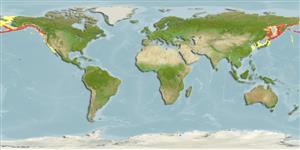أشلاق (القروش و الشفانين) (sharks and rays) >
Squaliformes (Sleeper and dogfish sharks) >
Somniosidae (Sleeper sharks)
Etymology: Somniosus: Latin for sleepy, reflecting Lesueur’s surmise that these sharks are slow or sluggish because of their relatively small fins (hence the name sleeper sharks). (See ETYFish); pacificus: -icus (L.), belonging to: the Pacific Ocean (specifically, the North Pacific), where it occurs (also in Arctic Ocean). (See ETYFish).
Environment: milieu / climate zone / depth range / distribution range
البيئة
بحري قاعية التغذية و المعيشة; نطاق العمق 0 - 2205 m (Ref. 119696). Boreal; 72°N - 23°N, 121°E - 110°W
North Pacific and Arctic: Taiwan to Japan and Kuril Islands, Sea of Okhotsk, southeastern Kamchatka, Commander and Aleutian Islands, and southern Baja California to Gulf of Alaska, Bering Sea, Chukchi Sea and Beaufort Sea.
الحجم / وزن / العمر
Maturity: Lm ? range ? - ? cm
Max length : 440 cm TL ذكر/ مختلط الجنس; (Ref. 247); 430.0 cm TL (female)
الأشواك الظهرية (المجموع) : 0; شوكة شرجية: 0. Diagnosis: Somniosus pacificus differs from S. antarcticus by the following characters: interdorsal space about 70% of prebranchial length (vs. 80%); height of first dorsal fin about 3.7% of precaudal length (PCL) (vs. 3.0%); height of second dorsal fin about 3.4% of PCL (vs. 2.9%); number of turns in spiral valve 32-37 (mode 33) (vs. 36-41, mode 39); precaudal vertebrae 28-30 (mode 29) (vs. 30-31, mode 30) (Ref. 50224).
Demersal and mesobenthopelagic (Ref. 119696); found on continental shelves and slopes (Ref. 247). At high latitudes, occasionally occurs in littoral and even intertidal areas; in lower latitudes it may never come to the surface and ranges down to at least 2,000 m (Ref. 247), reported to about 2,205 m in the Hawaiian Is. as recorded by camera arrays (Ref. 119696). Feeds on bottom animals such as fishes, octopi, squids, crabs and tritons; also harbor seals and carrion (Ref. 247). Ovoviviparous (Ref. 205), with 300 pups in a litter (Ref. 247), length at birth about 42 cm or less (Ref. 26346). The flesh contains a type of toxin which, when eaten, produces symptoms of drunkenness (Ref. 583). Possibly reaches lengths greater than 700 cm (Ref. 247). It is of limited importance in fisheries, with older small-scale commercial harvests reported in southern areas; and based on its population dynamics it can be sensitive to overfishing (Ref. 117245).
Life cycle and mating behavior
Maturities | التكاثر | Spawnings | Egg(s) | Fecundities | Larvae
Probably ovoviviparous (Ref. 247). Size at birth 42 cm or less (Ref. 26346). Distinct pairing with embrace (Ref. 205).
Yano, K., J.D. Stevens and L.J.V. Compagno, 2004. A review of the systematics of the sleeper shark genus Somniosus with redescriptions of Somniosus (Somniosus) antarcticus and Somniosus (Rhinoscymnus) longus (Squaliformes: Somniosidae). Ichthyol. Res. 51:360-373. (Ref. 50224)
IUCN Red List Status (Ref. 130435)
استخدامات بشرية
مصائد: غير ذات اهمية
أدوات
تقارير خاصة
Download XML
مصادر علي الأنترنت
Estimates based on models
Preferred temperature (Ref.
123201): 0.5 - 4.5, mean 2.3 °C (based on 400 cells).
Phylogenetic diversity index (Ref.
82804): PD
50 = 0.5313 [Uniqueness, from 0.5 = low to 2.0 = high].
Bayesian length-weight: a=0.00575 (0.00316 - 0.01049), b=3.09 (2.93 - 3.25), in cm total length, based on LWR estimates for this species & (Sub)family-body (Ref.
93245).
مستوى غذائي (Ref.
69278): 4.4 ±0.4 se; based on diet studies.
المرونه (Ref.
120179): منخفض, الحد الزمني الأدني لتضاعف عدد أفراد المجتمع 4.5-14 سنة (Fec=300; assuming tm<=10).
Fishing Vulnerability (Ref.
59153): Very high vulnerability (90 of 100).
Climate Vulnerability (Ref.
125649): Moderate vulnerability (38 of 100).
